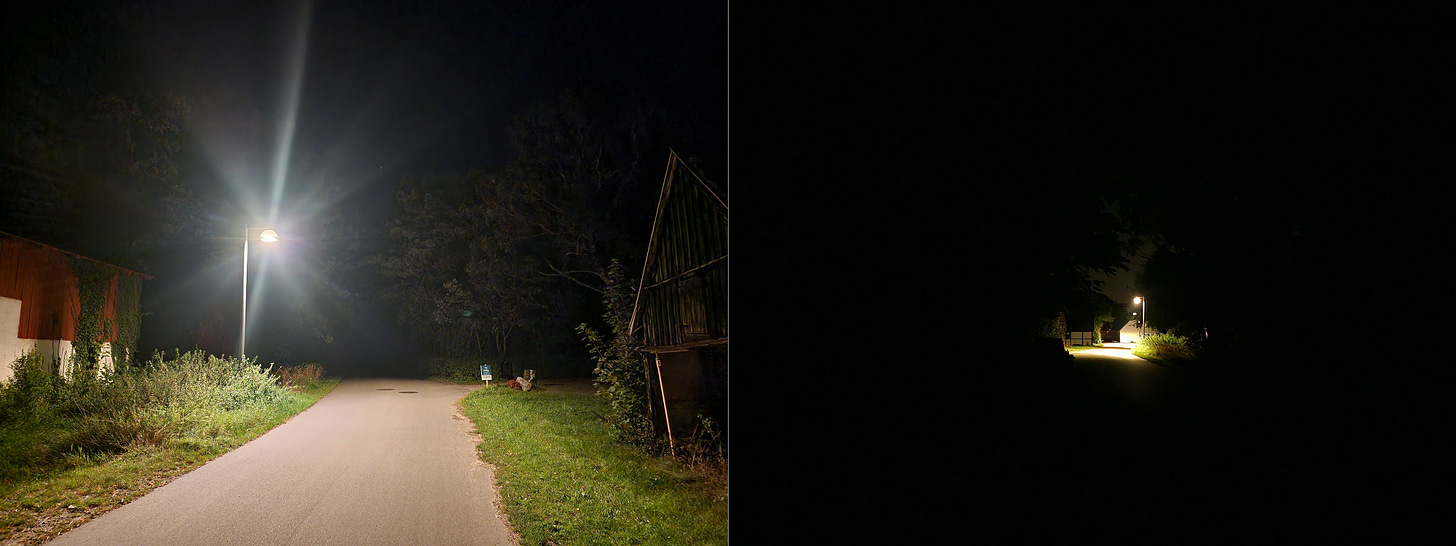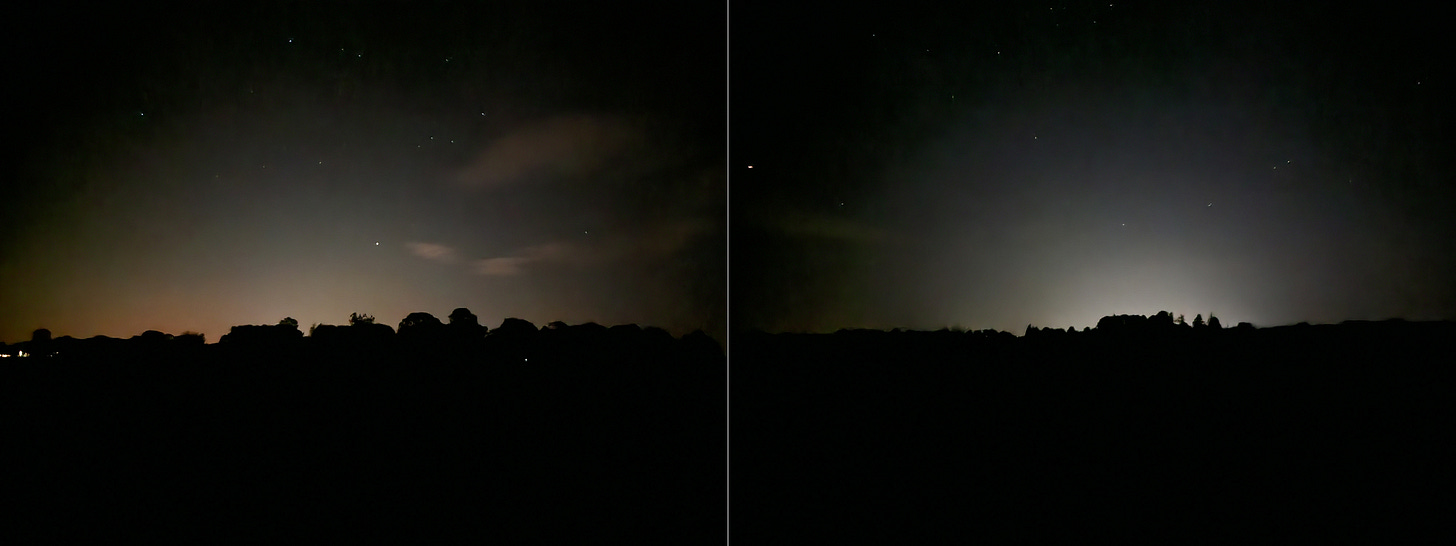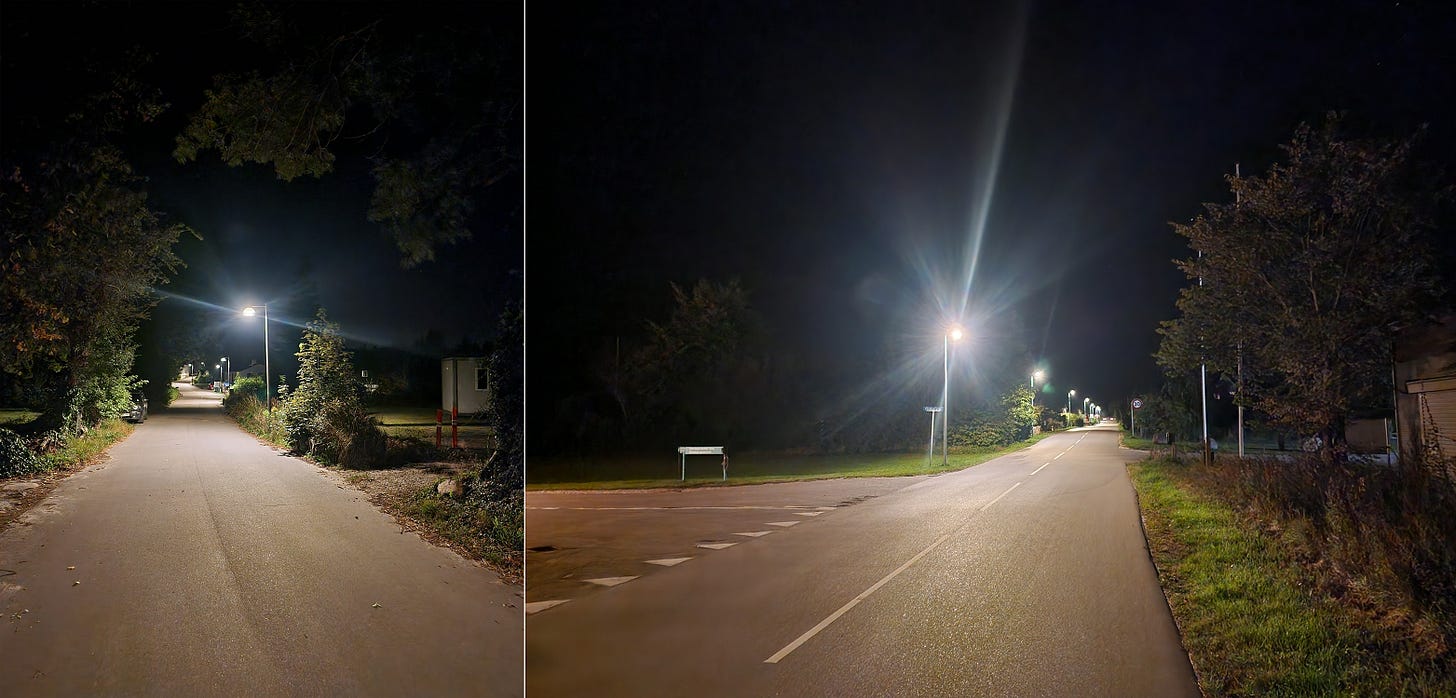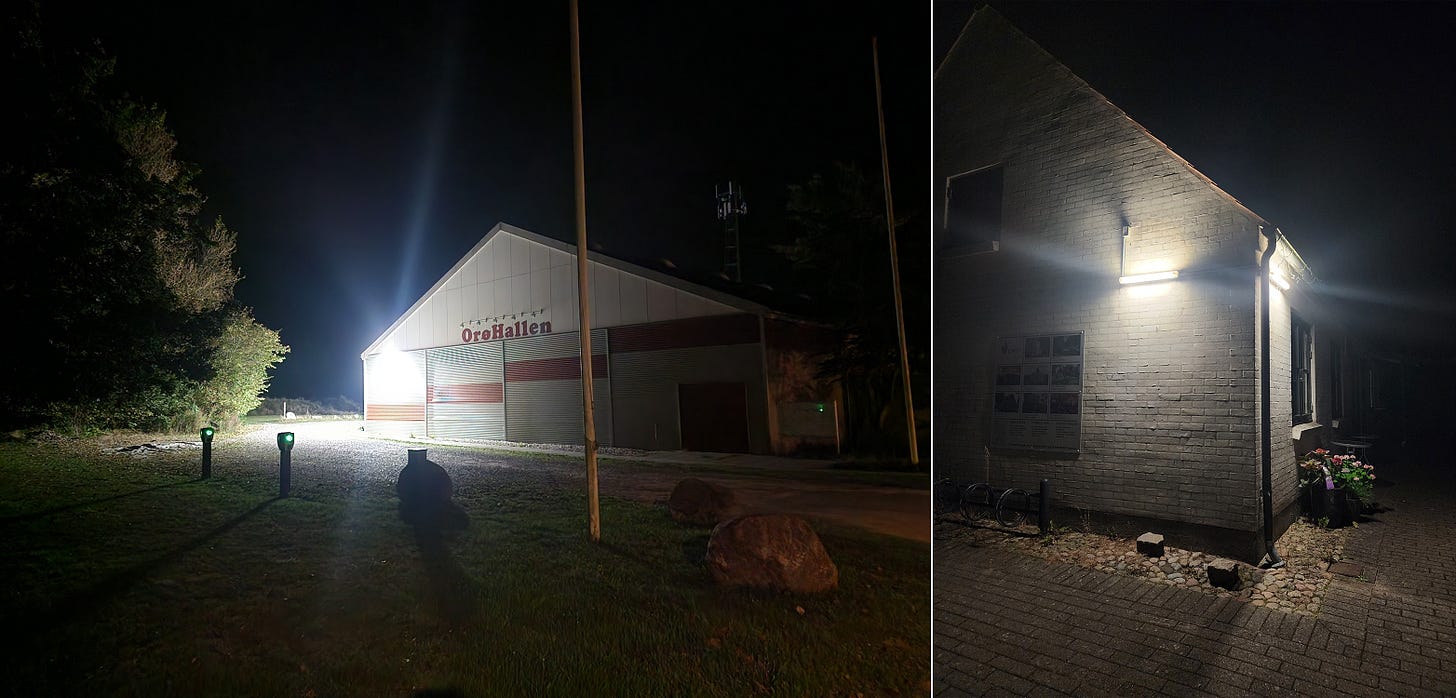At times my wife has woken up in the morning feeling unrested and so fatigued that she has found it difficult to function during the day. We've been travelling for over a year, staying in various places with different approaches to window coverings, sometimes none at all. Effective window coverings are crucial for protecting sleeping faces from the lights of cars, street lamps, neighbouring buildings, and a glowing sky. It seemed like her worst symptoms of fatigue followed spending a night in a poorly protected bedroom. I cover my eyes with a small lavender scented pillow she made, which seems to keep me well rested. Until recently she has had no such protection. To test this connection between light pollution and the quality of her sleep, she sewed two ends of a black sock together to make a headband that covers her eyes. Like magic, her daytime fatigue completely disappeared.
Plants, animals, fungi, cyanobacteria all have an internal mechanism in tune with the light and dark cycles of the earth's rotation. This is called the circadian rhythm. It's what regulates our body's energy, temperature, digestive system, and sleep patterns. Upon registering that darkness has arrived, our eyes send a message to the pineal gland, which secretes melatonin to mark the setting of the sun. Melatonin is a powerful free roaming anti-oxidant that targets potentially cancerous cells. It's crucial for a healthy immune system and helps us sleep. The disruption of our circadian rythm via exposure to artificial lights at night puts us at a higher risk of cancer, obesity, insomnia, anxiety, and depression. Night workers are especially vulnerable.
A few years ago I sat in on a panel discussion about “the night”. I don't remember the theme exactly, but there were architects, planners, and sociologists giving presentations on how to better accommodate the diverse needs of people in urban areas during the night. There was no talk about the consequences of artificial light. After an American lighting designer gave a presentation, I asked her to comment on the connection between artificial lights, ecology, and health. Her response would have made a cigarette lobbyist smile.
To paraphrase, she said: “One study comes out linking lighting to cancer. The next day a study will say there is no link. The science is inconclusive. I was hired to illuminate a dark park where people go to see nocturnal animals. I'm going to brighten it up so when people visit the park to see the animals no one will fall in the river.”
I don't know what I should have expected. If too many people begin talking about the harms of artificial lights, lighting designers might not only be out of business, they might get sued. Illuminating dark parks filled with nocturnal animals may deprive the place of what makes it special. As the work of scientist Johan Eklöf shows, especially in his book Darkness Manifesto: An unilluminated church that houses bats becomes batless once illuminated.
In the Summer of 2024, I read The End of Night: Searching for Natural Darkness in an Age of Artificial Light. Author Paul Bogard takes the reader on a journey from the brightest places to the darkest, beginning in Las Vegas and ending in Death Valley. I was on Orø, a small heart shaped Danish island, to feed a cat while the owner was away. My wife and I had a bedroom in a 400 year-old farm house. Our room, with its low gabled ceiling, had a mattress on the floor. The windows weren't covered. Bath towels seemed to do the trick.
Denmark has two officially designated Dark Sky Places, the islands of Møn and Nyord. These are special places where visitors can experience a darkness deep enough to fill the sky with stars. Orø's brochure boasts of its starry nights, but I figured Orø would have made that list if it had a spectacular night sky. Inspired by Bogard's journey, I decided to venture out to see for myself.
I love being out at night and how darkness transforms spaces, like snow in winter. I have night walked since middle school. A friend and I would walk around the streets of Brandon, Manitoba to look at tags and graffiti. He was into graffiti. I came along to keep him company. We didn't go out together so often after he was caught and charged for vandalism. Luckily for me, I didn't go out that night.
I still go for night walks, if I don't get enough exercise during the day and want to mentally process things I've been thinking about. Back when I was growing up in Brentwood Trailer Court, I would walk along a north/south dirt and gravel road marking the boundaries of a hay field. Trees blocked lights from the surrounding areas. Over the field I saw shooting stars almost every night. On darker, usually very cold, nights I could make out the Milky Way. I came off that road into suburbia and I remember the pain in my eyes from the bright lights. This must be how a deer feels. Suburban sprawl has now consumed the field, blotting out the stars with its pretentious lights, like so many fields on the peripheries of urban areas across the world.
For a small island like Orø, in a country known for being bicycle friendly, I was surprised by how many people drove cars1. When one of the two ferries landed, a stream of cars flowed through the streets. The guy across the street from us had five vehicles evenly spaced on his lawn. An island this small could easily be car free. A bike ride to the ferry is maximum 7 kms, probably 3 kms for most, and the train station is only 0.7 kms (0.4 miles) from the ferry terminal on the bigger island of Zealand. The presence of cars and reckless drivers make for potentially dangerous roads, especially for a walker out at night. I walked through the empty streets in the village of Bybjerg under the glaring light of the street lamps, shining as brightly as daylight, toward the darkness of the dirt farm roads.
Shielded lamps are often proposed to reduce the accumulation of artificial light in the sky, otherwise known as sky glow. Lamp shields would be an improvement on the top of Bybjerg's unshielded lamps, but shields don't prevent surfaces from being illuminated and the light from those surfaces reflecting into the sky. Mayflies mistake illuminated asphalt for water and lay eggs on it, explain György Kriska, Gábor Horváth, and Sándor Andrikovics in Why Do Mayflies Lay Their Eggs En Masse on Dry Asphalt Roads? Water-Imitating Polarized Light Reflected From Asphalt Attracts Ephemeroptera.
Mayfly populations have fallen by half between 2012 and 2020. Within this time period, many municipalities replaced orange glowing street lamp lights with brighter and more efficient LEDs. The decline of any insect population is catastrophic news for ecosystems. Artificial lights at night impact wildlife in ways we don't fully understand, but it's highly likely that light pollution is a major driving force behind the current mass extinction event.
Private and public dwellings on Bybjerg, the restaurant, the gas station, the Orø community hall (pictured left), and the cafeteria (pictured right) leave their lights on all night. Notice also the green lights on the electrical sockets the hall parking lot. I'm not sure what those are for, but they are becoming more common. The florescent lights on the cafeteria are on all day and night. None of these lights are necessary, they are in addition to the street lamps.

Our eyes are capable of adjusting to decreasing light, if we are patient enough to allow them to. Someone driving into the darkness from a bright place needs time for their eyes to adjust. If they drive too fast, they might be blind to a person or animal on the other side. Someone walking along a brightly lit road can't see past where the light begins to fade, but they are highly visible to a predator outside of the glow. Cut back on the number of lights, dim the remaining, colouring them red. These are measures that would make roads safer at night, but something more is needed. Cars have to either slow down or be banned.
Past the last lamp of Bybjerg and with my eyes adjusting to the new darkness, I went a few hundred metres down a dirt road through the field to see what stars appeared. There weren't as many as I remembered seeing back in Brandon. All the lights from Bybjerg and neighbouring urban areas flooded the sky.

Before Denmark, my wife and I spent a few months in a French hamlet called Tarassac in the Parc Naturel Régional du Haut-Languedoc. It was a similar mission, feeding three cats while their owner was away for cancer treatment (she had a full recovery). Tarassac has seen better days. Half the buildings are in ruins. Half of the occupied buildings are holiday homes. At least that's what a neighbour told me. Something special about Tarassac is the dramatic natural beauty of the Orb Valley, a biodiversity hotspot. To protect this biodiversity, street lamps are turned off at 23:00h and kept off until 6:00h.

Tarassac's night sky is filled with stars, far more than in the fields of Bybjerg. I didn't need to go into a field to see them. I could see the stars from inside the house. At sunset, the air filled with fluttering insects and bats swooping in to feed. Most of the residents went along with the initiative, but not all. Some left their porch lights on. A holiday home across the street from us had a white security light that stayed on all night and lit up their garden. That was one of the holiday homes. The owners were worried about squatters. Despite the efforts of hamlets and villages like Tarassac, the mountain tops don't hold back the sky glow. The Orb Valley is no Death Valley after all.
When it came time to leave Tarassac, we stayed in Bezier for a night before catching a train north to Brittany. I looked out the window and waited for the street lamps to turn off, but they never did. Tarassac and the other settlements part of this initiative show that street lamps don't need to be left on all night. Biodiversity can be protected and energy saved. To ensure that people don't DIY neighbourhood lighting, a more widespread information campaign is needed to inform people about what's at stake.
Energy demand plummets when we turn off our electronics and go to sleep. Street lamps, parking lot lights, shop lights, and security lights provide avenues for burning energy produced in the night. The purpose of this is to stabilize prices and secure customers for otherwise unusable energy, as scaling down energy production during the night and powering up again in the day is inefficient. This theory is floated in The End of Night and I wish it was explored more.
An alternative approach would be to turn off the lights, reduce the amount of energy produced during the day, and store the nighttime energy to supplement daytime use. Energy profits would likely take a hit. That's the problem with big centralized power plants. It makes the common conception of solar power's weakness become a strength.
We live in an age of light emitting electronics. Even my electric toothbrush has an annoying white LED light. If I'm using the computer in the evening I begin to feel a strain in my eyes. I switch on the “night mode” setting and immediately the strain goes away. Night mode filters out blue light. When we see blue light, our brain registers it as the daytime sky, suppressing the secretion of melatonin. Red lights don't seem to have that effect because they don't contain blue. Blue filters aren't a tool for energy reduction, but they may be more circadian rythm friendly. I've been trying to be on the computer less and write with paper more. The paperless movement was well intended, but now biomass power plants burn freshly cut forests to power computers that store paperless data. How about a reduction in useless paperwork?
When I'm out and about in cities, I walk by cafes and restaurants that are decked out in tacky lights and think “what a waste!” This business practice is inspired by the behaviour of a moth around a flame, customers are drawn toward lights. My wife and I ate at a restaurant called Café Kosmos in Odense, Denmark. Each table had a single lamp with an on/off switch. Enough light was coming in through the window, it was noon after all. I turned the lamp off. I'm not sure if the staff even noticed.
Street lamps with on/off switches and dimmers would give communities control over neighbourhood lighting. Street lamps lower to the ground would concentrate light on the area it is supposed to illuminate while reducing its spread. A short history of the street lamp in The End of Night claims tall street lamps were installed in reaction to people smashing their lower varieties. The vandals probably couldn't sleep because of the new lights.
In our homes we have little control by design. We flick a single switch and it turns on several lights all over ceiling. In most cases one thoughtfully placed light will do the trick. A single lamp directed at the book we're reading. One above a work surface. A soft red light for an evening get together with friends.
Furniture can be arranged to maximize natural daytime lighting. If there is not enough natural light coming into a building, then the layout might need to change and the window size be made larger. Buildings constructed before the invention of electricity often have large windows to maximize the amount of sunlight in a home. Windows at the tops of doors allow sunlight to enter into rooms in that are not attached to exterior walls, like foyers.
We can reduce light pollution by covering our windows when we have lights on. As already mentioned, shielded lights don't solve the problem of light pollution, but many people live on streets with lights that could benefit from shields. The trespassing of light, say from a neighbour into your home or garden, is caused by carelessness and is easily preventable. Trespassing lights should be a violation of building code.
If more municipal governments organized to shut off municipal lights at 22:00h and kept them off until 7:00h and replaced necessary lights with dimmable red lights, the problem of artificial lighting would vanish. Perhaps we would see a rebound in biodiversity.
One final thing that came up recently: My mom lives in a housing cooperative for seniors. She told me they recently had a meeting about reducing energy costs in the building. Currently they are paying over $10,000 (Canadian) a month for energy. My mom asked if the lights in the hallway could be turned off. They are on all day and night. The light seeps into apartments under the crack in the door, like in a hotel.
The manager said no, “it's housing for seniors so the lights need to be on at all times.” So my mom and I talked about this for a while. I mentioned that in many of the apartments we've stayed in, the hallway lights are on timers. You press the button, the light is on for a minute then it turns off. She said she would like to see the hallway lights in her building to be motion activated, like the ones in her shared laundry room.
For architects, planners, municipal managers, environmentalists, health advocates, and lighting designers, the question of lighting must be considered more carefully to reduce harm to biodiversity and health. No longer should lights stay on just in case they are needed. They should be there when they needed, but have to be activated by switch or motion sensors when the need arises, and turned off when the need is done.
Some questions and activities for readers. How bright is your neighbourhood at night? Can you see any stars? You can compare your experience with this handy light pollution map. Do you feel fatigued during the day? How bright is your bedroom at night? I know night walking can be dangerous depending on where or who you are, but if you have the opportunity and can go out with friends, I think it's worthwhile. Take note of the night sky, or lack thereof, and become an advocate for darkness.
Thank you for reading and a special thank you to my wife Alexandra for reading over everything before I publish. I’ve been trying to improve my writing skills. I’m going through a book by Suzanne McConnell and Kurt Vonnegut called “Pity the Reader: On Writing With Style”. I highly recommend it for writers and nonwriters alike! :D
That was my impression in Copenhagen too.





